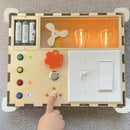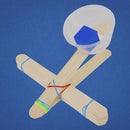Introduction: Top Launcher
Gyroscopic Whirligigs is a project that breaks away from the usual fare and offers students a unique engineering gizmo that always impresses onlookers. This quirky contraption isn't a true gyroscope, but it relies on the gyroscopic effect to produce some impossible-looking stunts.
You can find the lesson plan, 1-page project sheet, and more project ideas at STEM-Inventions.com
Step 1: Materials
The Engineering Creation Kit has everything you need for this project and many more from STEM Inventions.
4 craft sticks
4 craft sticks cut in half
6 craft cubes (Bulk pack)
1 1/8" dowel
1 cable tie
12" length of string
Hot glue with safety tip
When you make a purchase through these links, I may earn an affiliate commission at zero cost to you.
Step 2: The Launcher
The launcher is very simple to make. The only non-obvious element that you should impress upon your students is the gap left at the ends of the launcher. This gap allows the wheels to rotate without falling off prematurely. The gap is only necessary on one end, but I show students to leave a gap on both ends. Sometimes students accidentally place the end with the gap near the grip. If the gap is on both ends, then the orientation doesn't matter and construction a little more intuitive.
Step 3: The Spinner
The spinner can be made with different wheel configurations and in different lengths, however this example tends to produce pretty interesting effects.
Choose a straight skewer for this step. Most skewers will work, but some are severely warped.
Cut the skewer to size and tightly attach a cable tie. Cut the excess off. The cable tie will allow the pull cord to hook onto the spinner, which will make it easier to wind up.
The two inner wheels prevent the string from getting caught on the launcher during the release. The outer wheels aren't necessary, but they do create some dynamic gyroscope effects. Without them, the spinner tends to act more like a top.
Encourage your students to experiment with this step!
Step 4: The Handle and Pull Cord
The handle gives students something to firmly grasp during the launch, but it also acts as a weight to help keep the string taught while winding up the spinner (see the next step).
Tie the string to the handle and use glue to fix it in place.
The other end of the pull cord has a small loop which will hook onto the spinner hook. I use a simple square knot for this. Use a small dab of hot glue to prevent the knot from loosening over time. Young students may have a difficult time tying the knot correctly, so I often do this step for them.
Step 5: How to Launch
Clearly demonstrate and explain how to launch the spinner using these steps:
- Hook the pull cord loop onto the wheels. Allow the pull cord handle to dangle from the wheels and use your hands to wind it up. The weight of the handle keeps the string taught as it is wound up. If it's wound up too loose, it may get tangled when used.
- Place the wheels in the gap at the top of the launcher.
- Switch the position of your hands so that one hand is firmly gripping the launcher and the other is holding the pull cord handle.
- While holding the launcher straight up and down, give the pull cord a hard tug directly downward and follow through. If the spinner doesn't leap off of the launcher, then simply tip the launcher forward and allow the spinner to fall off.
Step 6: Advanced Idea: Racing Wheels
The launcher is placed on the ground while the ripcord is pulled. Elevating the launcher with 4 craft cubes is necessary to prevent the wheels from touching the ground.
Step 7: Safety, Tips and Troubleshooting
- Be sure your students have plenty of space to use their whirligigs. Someone may accidentally strike another person if they are operating their whirligig a little too enthusiastically.
- This activity uses string, which somehow translates into the perfect material to make nunchucks. Please don't allow your students to make nunchucks.
- Whirligigs work best on a large, smooth floor with little obstructions. If your room is cramped or carpeted, consider allowing students to test their creations in a hallway or outside.
- Operating a whirligig can be more challenging than actually building one. It requires a lot of coordination. Most commonly, students will pull the pull cord down and off to the side or behind them. This may pull the spinner off of the launcher prematurely or cause it to jam. Help students who are having difficulty launching their whirligigs by clearly showing how the pull cord must go straight down.




